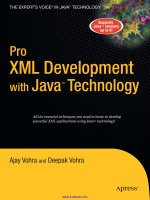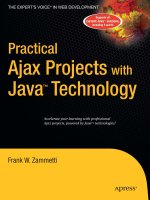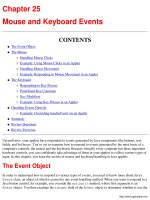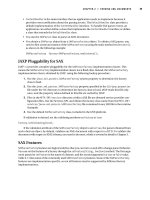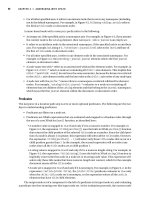Pro XML Development with Java Technology 2006 phần 2 pdf
Bạn đang xem bản rút gọn của tài liệu. Xem và tải ngay bản đầy đủ của tài liệu tại đây (1.97 MB, 35 trang )
14
CHAPTER 1
■ INTRODUCING XML AND JAVA
<xsd:complexType name="paperType" >
<xsd:all>
<xsd:element name="title" type="titleType" />
<xsd:element name="author" type="authorType" />
<! we have yet to define titleType and authorType >
</xsd:all>
</xsd:complexType>
Named Model Groups
You can define all the model groups you’ve seen so far—sequence, choice, and all—within a named
model group. The named model group in turn can be referenced in complex types and in other
named model groups. This promotes the reusability of model groups. For example, you could define
paperGroup as a named model group and refer to it in the paperType complex type using the ref
attribute, as shown in the following example:
<?xml version='1.0' encoding='UTF-8' ?>
<xsd:schema xmlns:xsd=" /> <xsd:complexType name="paperType">
<xsd:group ref="paperGroup" />
</xsd:complexType>
<xsd:group name="paperGroup">
<xsd:all>
<xsd:element ref="title" />
<xsd:element ref="author" />
</xsd:all>
</xsd:group>
</xsd:schema>
Cardinality
You specify the cardinality of a construct with the minOccurs and maxOccurs attributes. You can
specify cardinality on an element declaration or on the sequence, choice, and all model groups, as
long as these groups are specified outside a named model group. You can specify named model
group cardinality when the group is referenced in a complex type. The default value for both the
minOccurs and maxOccurs attributes is 1, which implies that the default cardinality of any construct is
1, if no cardinality is specified.
If you want to specify that a catalogType complex type should allow zero or more occurrences
of journal elements, you can do so as shown here:
<xsd:complexType name="catalogType" >
<xsd:sequence>
<xsd:element maxOccurs="unbounded" minOccurs="0" ref="journal" />
</xsd:sequence>
</xsd:complexType>
Attribute Declarations
You can specify an attribute declaration in a schema with the attribute construct. You can specify
an attribute declaration within a schema or a complexType. For example, if you want to define the
title and publisher attributes in the catalogType complex type, you can do so as shown here:
Vohra_706-0C01.fm Page 14 Wednesday, June 28, 2006 6:27 AM
CHAPTER 1 ■ INTRODUCING XML AND JAVA
15
<xsd:complexType name="catalogType">
<xsd:sequence>
<xsd:element ref="journal" minOccurs="0" maxOccurs="unbounded" />
</xsd:sequence>
<xsd:attribute name="title" type="xsd:string" use="required" />
<xsd:attribute name="publisher" type="xsd:string"
use="optional" default="Unknown" />
</xsd:complexType>
An attribute declaration may specify a use attribute, with a value of optional or required. The
default use value for an attribute is optional. In addition, an attribute can specify a default value
using the default attribute, as shown in the previous example. When an XML document instance
does not specify an optional attribute with a default value, an attribute with the default value is
assumed during document validation with respect to its schema. Clearly, an attribute with a default
value cannot be a required attribute.
Attribute Groups
An attributeGroup construct specifies a group of attributes. For example, if you want to define the
attributes for a catalogType as an attribute group, you can define a catalogAttrGroup attribute group,
as shown here:
<xsd:attributeGroup name="catalogAttrGroup" >
<xsd:attribute name="title" type="xsd:string" use="required" />
<xsd:attribute default="Unknown" name="publisher"
type="xsd:string" use="optional" />
</xsd:attributeGroup>
You can specify an attributeGroup in a schema, complexType, and attributeGroup. You can
specify the catalogAttrGroup shown previously within the schema element and can reference it using
the ref attribute in the catalogType complex type, as shown here:
<xsd:complexType name="catalogType" >
<xsd:sequence>
<xsd:element maxOccurs="unbounded" minOccurs="0" ref="journal" />
</xsd:sequence>
<xsd:attributeGroup ref="catalogAttrGroup" />
</xsd:complexType>
Simple Content
A simpleContent construct specifies a constraint on character data and attributes. You specify a
simpleContent construct in a complexType construct. Two types of simple content constructs exist:
an extension and a restriction.
You specify simpleContent extension with an extension construct. If you want to define an
authorType as an element that allows a string type in its content and also allows an email attribute,
you can do so using a simpleContent extension that adds an email attribute to a string built-in type,
as shown here:
<xsd:complexType name="authorType" >
<xsd:simpleContent>
<xsd:extension base="xsd:string" >
<xsd:attribute name="email" type="xsd:string" use="optional" />
</xsd:extension>
</xsd:simpleContent>
</xsd:complexType>
Vohra_706-0C01.fm Page 15 Wednesday, June 28, 2006 6:27 AM
16
CHAPTER 1
■ INTRODUCING XML AND JAVA
You specify a simpleContent restriction with a restriction element. If you want to define a
titleType as an element that allows a string type in its content but restricts the length of this content
to between 10 to 256 characters, you can do so using a simpleContent restriction that adds the
minLength and maxLength constraining facets to a string base type, as shown here:
<xsd:complexType name="titleType" >
<xsd:simpleContent>
<xsd:restriction base="xsd:string" >
<xsd:minLength value="10" />
<xsd:maxLength value="256" />
</xsd:restriction>
</xsd:simpleContent>
</xsd:complexType>
Constraining Facets
Constraining facets are a powerful mechanism for restricting the content of a built-in simple type.
We already looked at the use of two constraining facets in the context of a simple content construct.
Table 1-2 has a complete list of the constraining facets. These facets must be applied to relevant built-in
types, and most of the time the applicability of a facet to a built-in type is fairly intuitive. For complete
details on the applicability of facets to built-in types, please consult XML Schema Part 2: Datatypes.
Table 1-2. Constraining Facets
Facet Description Example Value
length Number of units of length 8
minLength Minimum number of units
of length, say m1
20
maxLength Maximum number of units
of length
200 (Greater or equal to m1)
pattern A regular expression [0-9]{5} (for first part of a U.S. ZIP code)
enumeration An enumerated value Male
whitespace Whitespace processing preserve (as is), replace (new line and
tab with space), or collapse (contiguous
sequences of space into a single space)
maxInclusive Inclusive upper bound 255 (for a value less than or equal to 255)
maxExclusive Exclusive upper bound 256 (for a value less than 256)
minExclusive Exclusive lower bound 0 (for a value greater than 0)
minInclusive Inclusive lower bound 1 (for a value greater than or equal to 1)
totalDigits Total number of digits in a
decimal value
8
fractionDigits Total number of fractions
digits in a decimal value
2
Vohra_706-0C01.fm Page 16 Wednesday, June 28, 2006 6:27 AM
CHAPTER 1 ■ INTRODUCING XML AND JAVA
17
Complex Content
A complexContent element specifies a constraint on elements (including attributes). You specify a
complexContent construct in a complexType element. Just like in the case of simple content, complex
content has two types of constructs: an extension and a restriction.
You specify a complexContent extension with an extension element. If, for example, you want to
add a webAddress attribute to a catalogType complex type using a complex content extension, you
can do so as shown here:
<xsd:complexType name="catalogTypeExt" >
<xsd:complexContent>
<xsd:extension base="catalogType" >
<xsd:attribute name="webAddress" type="xsd:string" />
</xsd:extension>
</xsd:complexContent>
</xsd:complexType>
You specify a complexContent restriction with a restriction element. In a complex content
restriction, you basically have to repeat, in the restriction element, the part of the base model you
want to retain in the restricted complex type. If, for example, you want to restrict the paperType
complex type to only a title element using a complex content restriction, you can do so as shown here:
<xsd:complexType name="paperTypeRes" >
<xsd:restriction base="paperType" >
<xsd:all>
<xsd:element name="title" type="titleType" />
</xsd:all>
</xsd:restriction>
</xsd:complexType>
A complex content restriction construct has a fairly limited use.
Simple Type Declarations
A simpleType construct specifies information and constraints on attributes and text elements. Since
XML Schema has 44 built-in simple types, a simpleType is either used to constrain built-in datatypes
or used to define a list or union type. If you wanted, you could have specified authorType as a simple
type restriction on a built-in string type, as shown here:
<xsd:element name="authorType" >
<xsd:simpleType>
<xsd:restriction base="xsd:string" >
<xsd:minLength value="10" />
<xsd:maxLength value="256" />
</xsd:restriction>
</xsd:simpleType>
</xsd:element>
List
A list construct specifies a simpleType construct as a list of values of a specified datatype. For example,
the following is a simpleType that defines a list of integer values in a chapterNumbers element:
Vohra_706-0C01.fm Page 17 Wednesday, June 28, 2006 6:27 AM
18
CHAPTER 1
■ INTRODUCING XML AND JAVA
<xsd:element name="chapterNumbers" >
<xsd:simpleType>
<xsd:list itemType="xsd:integer" />
</xsd:simpleType>
</xsd:element>
The following example is an element corresponding to the simpleType declaration defined
previously:
<chapterNumbers>8 12 11</chapterNumbers>
Union
A union construct specifies a union of simpleTypes. For example, if you first define chapterNames as a
list of string values, as shown here:
<xsd:element name="chapterNames">
<xsd:simpleType>
<xsd:list itemType="xsd:string"/>
</xsd:simpleType>
</xsd:element>
then you can specify a union of chapterNumbers and chapterNames as shown here:
<xsd:element name="chapters" >
<xsd:simpleType>
<xsd:union memberTypes="chapterNumbers, chapterNames" />
</xsd:simpleType>
</xsd:element>
This is an example element corresponding to the chapters declaration defined previously:
<chapters>8 XSLT 11</chapters>
Of course, since list values may not contain any whitespace, this example is completely
contrived because chapter names in real life almost always contain whitespace.
Schema Example Document
Based on the preceding discussion, Listing 1-3 shows the complete example schema document for
the example XML document in Listing 1-2.
Listing 1-3. Complete Example Schema Document
<?xml version='1.0' encoding='UTF-8' ?>
<xsd:schema xmlns:xsd=" /> <xsd:element name="catalog" type="catalogType" />
<xsd:complexType name="catalogType">
<xsd:sequence>
<xsd:element maxOccurs="unbounded" minOccurs="0" ref="journal" />
</xsd:sequence>
<xsd:attribute name="title" type="xsd:string" use="required"/>
<xsd:attribute default="Unknown" name="publisher" type="xsd:string" />
</xsd:complexType>
Vohra_706-0C01.fm Page 18 Wednesday, June 28, 2006 6:27 AM
CHAPTER 1 ■ INTRODUCING XML AND JAVA
19
<xsd:element name="journal">
<xsd:complexType>
<xsd:choice>
<xsd:element name="article" type="paperType"/>
<xsd:element name="research" type="paperType"/>
</xsd:choice>
</xsd:complexType>
</xsd:element>
<xsd:complexType name="paperType">
<xsd:all>
<xsd:element name="title" type="titleType"/>
<xsd:element name="author" type="authorType"/>
</xsd:all>
</xsd:complexType>
<xsd:complexType name="authorType">
<xsd:simpleContent>
<xsd:extension base="xsd:string">
<xsd:attribute name="email" type="xsd:string" />
</xsd:extension>
</xsd:simpleContent>
</xsd:complexType>
<xsd:complexType name="titleType">
<xsd:simpleContent>
<xsd:restriction base="xsd:string">
<xsd:minLength value="10"/>
<xsd:maxLength value="256"/>
</xsd:restriction>
</xsd:simpleContent>
</xsd:complexType>
</xsd:schema>
Introducing the Eclipse IDE
We developed the Java applications in this book using the Eclipse 3.1.1 integrated development
environment (IDE), which is by far the most commonly used IDE among Java developers. You can
download it from The following sections are a quick introduction to Eclipse;
we cover all you need to know to build and execute the Java applications included in this book. In
particular, we offer a quick tutorial on how to create a Java project and how to create a Java applica-
tion within a Java project.
Creating a Java Project
To create a Java project in Eclipse, select File ➤ New ➤ Project. In the New Project dialog box, select
Java Project, and then click Next, as shown in Figure 1-1.
Vohra_706-0C01.fm Page 19 Wednesday, June 28, 2006 6:27 AM
20
CHAPTER 1
■ INTRODUCING XML AND JAVA
Figure 1-1. Selecting the New Project Wizard
On the Create a Java Project screen, specify a project name, such as Chapter1. In the Project
Layout section, select Create Separate Source and Output Folders, and click Next, as shown in Figure 1-2.
Vohra_706-0C01.fm Page 20 Wednesday, June 28, 2006 6:27 AM
CHAPTER 1 ■ INTRODUCING XML AND JAVA
21
Figure 1-2. Creating a Java project
On the Java Settings screen, add the required project libraries under the Libraries tab, and click
Finish, as shown in Figure 1-3.
Vohra_706-0C01.fm Page 21 Wednesday, June 28, 2006 6:27 AM
22
CHAPTER 1
■ INTRODUCING XML AND JAVA
Figure 1-3. Accessing the Java Settings screen
This adds a Java project to the Package Explorer in Eclipse, as shown in Figure 1-4.
Figure 1-4. Viewing the Java project in the Package Explorer
Vohra_706-0C01.fm Page 22 Wednesday, June 28, 2006 6:27 AM
CHAPTER 1 ■ INTRODUCING XML AND JAVA
23
Setting the Build Path
The build path of a Java project includes the JAR files and package folders required to compile
various Java class files in a project. To add JAR files and package folders to a project’s build path,
select the project node on the Package Explorer tab, and select Project ➤ Properties. In the Properties
dialog box, select the Java Build Path node, add the external JAR (external to project) files by clicking
the Add External JARs button, and add the internal JAR files by clicking the Add JARs button. You can
add package folders and libraries with the Add Class Folders and Add Library buttons, respectively.
The JARs and package folders in the project build path appear in the Java Build Path window. As an
example, it is assumed that xerces.jar is an external JAR file available at the C:\JDOM\jdom-1.0\lib
path, and it is added to the Java Build Path window with the Add External JARs button, as shown in
Figure 1-5.
Figure 1-5. Setting the Java build path
Creating a Java Package
To create a Java package within a Java project, select the project node in the Package Explorer, and
select File ➤ New ➤ Package. In the New Java Package dialog box, specify a package name, such as
com.apress.chapter1, and click the Finish button, as shown in Figure 1-6.
Vohra_706-0C01.fm Page 23 Wednesday, June 28, 2006 6:27 AM
24
CHAPTER 1
■ INTRODUCING XML AND JAVA
Figure 1-6. Creating a Java package
This adds a Java package to the Java project, as shown in Figure 1-7.
Figure 1-7. Viewing the Java package in Package Explorer
Creating a Java Class
To create a Java class, right-click a package node in the Package Explorer, and select New ➤ Class, as
shown in Figure 1-8.
On the New Java Class screen, specify the class name, class modifiers, and interfaces implemented,
and then click the Finish button, as shown in Figure 1-9.
Vohra_706-0C01.fm Page 24 Wednesday, June 28, 2006 6:27 AM
CHAPTER 1 ■ INTRODUCING XML AND JAVA
25
Figure 1-8. Creating new Java class
Figure 1-9. Specifying Java class settings
Vohra_706-0C01.fm Page 25 Wednesday, June 28, 2006 6:27 AM
26
CHAPTER 1
■ INTRODUCING XML AND JAVA
This adds a Java class to the Java project, as shown in Figure 1-10.
Figure 1-10. Viewing the Java class in the Package Explorer
Running a Java Application
To run a Java application, right-click the Java class in the Package Explorer, and select Run As ➤ Run,
as shown in Figure 1-11.
Vohra_706-0C01.fm Page 26 Wednesday, June 28, 2006 6:27 AM
CHAPTER 1 ■ INTRODUCING XML AND JAVA
27
Figure 1-11. Running a Java application
In the Run dialog box, select a Java Application configuration, or create a new Java Application
configuration by selecting Java Application ➤ New, as shown in Figure 1-12.
Vohra_706-0C01.fm Page 27 Wednesday, June 28, 2006 6:27 AM
28
CHAPTER 1
■ INTRODUCING XML AND JAVA
Figure 1-12. Creating a Java Application configuration
This creates a Java Application configuration. If any application arguments are to be set, specify
the arguments on the Arguments tab. To specify the project JRE, select the JRE tab. The JAR files and
packages folders in the build path are also automatically included in the Java classpath. You can add
classpath JAR files and package folders on the Classpath tab. To run a Java application, click Run, as
shown in Figure 1-13.
Vohra_706-0C01.fm Page 28 Wednesday, June 28, 2006 6:27 AM
CHAPTER 1 ■ INTRODUCING XML AND JAVA
29
Figure 1-13. Configuring and running a Java application
Importing a Java Project
The Java projects for the applications in this book are available from the Apress website (http://www.
apress.com). The easiest way to run these applications is to download and import these Java projects
into Eclipse. Before we cover how to import the Chapter1 project, you must delete the Chapter1 project
you just created, including its contents, by selecting it and hitting Delete key. Be sure to choose the
option to delete the contents when prompted.
To import a Java project, select File ➤ Import. In the Import dialog box, select Existing Projects
into Workspace, and click Next, as shown in Figure 1-14.
In the Import Projects dialog box, select a project directory with Browse button. Select a directory in
the Browse for Folder dialog box, and click OK, as shown in Figure 1-15. Click Finish to import the
project directory.
Vohra_706-0C01.fm Page 29 Wednesday, June 28, 2006 6:27 AM
30
CHAPTER 1
■ INTRODUCING XML AND JAVA
Figure 1-14. Importing a project
Figure 1-15. Selecting a directory
Vohra_706-0C01.fm Page 30 Wednesday, June 28, 2006 6:27 AM
CHAPTER 1 ■ INTRODUCING XML AND JAVA
31
This imports a Java project into the Eclipse IDE, as shown in Figure 1-16.
Figure 1-16. Viewing the project in the Package Explorer
Summary
In this chapter, we noted the different APIs that we will cover in detail in subsequent chapters and
offered quick primers on XML and XML Schema. We also introduced the Eclipse IDE, which was
used to build and execute all the example applications included in this book. In the next chapter, we
will discuss XML parsing in detail using the DOM, SAX, and StAX APIs.
Vohra_706-0C01.fm Page 31 Wednesday, June 28, 2006 6:27 AM
Vohra_706-0C01.fm Page 32 Wednesday, June 28, 2006 6:27 AM
33
■ ■ ■
CHAPTER 2
Parsing XML Documents
An XML document contains structured textual information. We covered the syntactic rules that
define the structure of a well-formed XML document in the primer on XML 1.0 in Chapter 1. This
chapter is about parsing the structure of a document to extract the content information contained
in the document.
We’ll start by discussing various objectives for parsing an XML document and by covering
various parsing approaches compatible with these objectives. We’ll discuss the advantages and
disadvantages of each approach and the appropriateness of them for particular applications. We’ll
then discuss specific parsing APIs that implement these approaches and are defined within JAXP 1.3,
which is included in J2SE 5.0, and Streaming API for XML (StAX), which is included in J2SE 6.0. We’ll
explain each API through code examples. Finally, we’ll offer instructions on how to build and execute
these code examples within the Eclipse IDE.
Objectives of Parsing XML
Parsing is the most fundamental aspect of processing an XML document. When an application
parses an XML document, typically it has three distinct objectives:
• To ensure that the document is well-formed
• To check that the document conforms to the structure specified by a DTD or an XML Schema
• To access, and maybe modify, various elements and attributes specified in the document, in
a manner that meets the specific needs of an application
All applications share the first objective. The second objective is not as pervasive as the first but
is still fairly standard. The third objective, not surprisingly, varies from application to application.
Prompted by the diverse access requirements of various applications, different parsing approaches
have evolved to satisfy these requirements. To date, you can take one of three distinct approaches to
parsing XML documents:
•DOM
1
parsing
•Push parsing
• Pull parsing
In the next section, we will give an overview of these three approaches and then offer a compar-
ative analysis of them.
1. You can find the Document Object Model (DOM) Level 3 Core specification at />DOM-Level-3-Core/.
Vohra_706-0C02.fm Page 33 Wednesday, June 28, 2006 6:38 AM
34
CHAPTER 2
■ PARSING XML DOCUMENTS
Overview of Parsing Approaches
In the following sections, we will give you an overview of the three major parsing approaches from a
conceptual standpoint. In later sections, we will discuss specific Java APIs that implement these
approaches. We will start with the DOM approach.
DOM Approach
The Document Object Model (DOM) Level 3 Core specification specifies platform- and language-neutral
interfaces for accessing and manipulating content and specifies the structure of a generalized
document. The DOM represents a document as a tree of Node objects. Some of these Node objects
have child node objects; others are leaf objects with no children.
To represent the structure of an XML document, the generic Node type is specialized to other
Node types, and each specialized node type specifies a set of allowable child Node types. Table 2-1
explains the specialized DOM Node types for representing an XML document, along with their allowable
child Node types.
Table 2-1. Specialized DOM Node Types for an XML Document
Specialized Node Type Description Allowable Child Node Types
Document Represents an
XML document
DocumentType, ProcessingInstruction,
Comment, Element(maximum of 1)
DocumentFragment Represents part of an XML
document
Element, ProcessingInstruction, Comment,
Text, CDATASection, EntityReference
DocumentType Represents a DTD for a
document
No children
EntityReference Represents an
entity reference
Element, ProcessingInstruction, Comment,
Text, CDATASection, EntityReference
Element Represents an element Element, ProcessingInstruction, Comment,
Text, CDATASection, EntityReference
Attr Represents an attribute Text, EntityReference
ProcessingInstruction Represents a processing
instruction
No children
Comment Represents a comment No children
Text Represents text, including
whitespace
No children
CDATASection Represents a CDATA section No children
Entity Represents an entity Element, ProcessingInstruction, Comment,
Text, CDATASection, EntityReference
Notation Represents a notation No children
Vohra_706-0C02.fm Page 34 Wednesday, June 28, 2006 6:38 AM
CHAPTER 2 ■ PARSING XML DOCUMENTS
35
The Document specialized node type is somewhat unique in that at most only one instance of this
type may exist within an XML document. It is also worth noting that the Document node type is a
specialized Element node type and is used to represent the root element of an XML document. Text
node types, in addition to representing text, are also used to represent whitespace in an XML document.
Under the DOM approach, an XML document is parsed into a random-access tree structure in
which all the elements and attributes from the document are represented as distinct nodes, with
each node instantiated as an instance of a specialized node type. So, for example, under the DOM
approach, the example XML document shown in Listing 2-1 would be parsed into the tree structure
(annotated with specialized node types) shown in Figure 2-1.
Listing 2-1. Example XML Document
<?xml version="1.0" encoding="UTF-8"?>
<catalog title="OnJava.com" publisher="O'Reilly">
<journal date="January 2004">
<article>
<title>Data Binding with XMLBeans</title>
<author>Daniel Steinberg</author>
</article>
</journal>
</catalog>
Figure 2-1. Annotated DOM tree for example XML document
The DOM approach has the following notable aspects:
• An in-memory DOM tree representation of the complete document is constructed before the
document structure and content can be accessed or manipulated.
• Document nodes can be accessed randomly and do not have to be accessed strictly in docu-
ment order.
• Random access to any tree node is fast and flexible, but parsing the complete document
before accessing any node can reduce parsing efficiency.
Vohra_706-0C02.fm Page 35 Wednesday, June 28, 2006 6:38 AM
36
CHAPTER 2
■ PARSING XML DOCUMENTS
• For large documents ranging from hundreds of megabytes to gigabytes in size, the in-memory
DOM tree structure can exhaust all available memory, making it impossible to parse such
large documents under the DOM approach.
• If an XML document needs to be navigated randomly or if the document content and structure
needs to be manipulated, the DOM parsing approach is the most practical approach. This is
because no other approach offers an in-memory representation of a document, and although
such representation can certainly be created by the parsing application, doing so would be
essentially replicating the DOM approach.
• An API for using the DOM parsing approach is available in JAXP 1.3.
Push Approach
Under the push parsing approach, a push parser generates synchronous events as a document is
parsed, and these events can be processed by an application using a callback handler model. An API
for the push approach is available as SAX
2
2.0, which is also included in JAXP 1.3. SAX is a read-only
API. The SAX API is recommended if no modification or random-access navigation of an XML document
is required.
The SAX 2.0 API defines a ContentHandler interface, which may be implemented by an applica-
tion to define a callback handler for processing synchronous parsing events generated by a SAX
parser. The ContentHandler event methods have fairly intuitive semantics, as listed in Table 2-2.
2. You can find information about Simple API for XML at />Table 2-2. SAX 2.0 ContentHandler Event Methods
Method Notification
startDocument Start of a document
startElement Start of an element
characters Character data
endElement End of an element
endDocument End of a document
startPrefixMapping Start of namespace prefix mapping
endPrefixMapping End of namespace prefix mapping
skippedEntity Skipped entity
ignorableWhitespace Ignorable whitespace
processingInstruction Processing instruction
Vohra_706-0C02.fm Page 36 Wednesday, June 28, 2006 6:38 AM
CHAPTER 2 ■ PARSING XML DOCUMENTS
37
In addition to the ContentHandler interface, SAX 2.0 defines an ErrorHandler interface, which
may be implemented by an application to receive notifications about errors. Table 2-3 lists the
ErrorHandler notification methods.
An application should make no assumption about whether the endDocument method of the
ContentHandler interface will be called after the fatalError method in the ErrorHandler interface
has been called.
Pull Approach
Under the pull approach, events are pulled from an XML document under the control of the appli-
cation using the parser. StAX is similar to the SAX API in that both offer event-based APIs. However,
StAX differs from the SAX API in the following respects:
• Unlike in the SAX API, in the StAX API, it is the application rather than the parser that controls
the delivery of the parsing events. StAX offers two event-based APIs: a cursor-based API and
an iterator-based API, both of which are under the application’s control.
• The cursor API allows a walk-through of the document in document order and provides the
lowest level of access to all the structural and content information within the document.
• The iterator API is similar to the cursor API but instead of providing low-level access, it provides
access to the structural and content information in the form of event objects.
• Unlike the SAX API, the StAX API can be used both for reading and for writing XML documents.
Cursor API
Key points about the StAX cursor API are as follows:
•The XMLStreamReader interface is the main interface for parsing an XML document. You can
use this interface to scan an XML document’s structure and contents using the next() and
hasNext() methods.
•The next() method returns an integer token for the next parse event.
• Depending on the next event type, you can call specific allowed methods on the XMLStreamReader
interface. Table 2-4 lists various event types and the corresponding allowed methods.
Table 2-3. SAX 2.0 ErrorHandler Notification Methods
Method Notification
fatalError Violation of XML 1.0 well-formed constraint
error Violation of validity constraint
warning Non-XML-related warning
Vohra_706-0C02.fm Page 37 Wednesday, June 28, 2006 6:38 AM
38
CHAPTER 2
■ PARSING XML DOCUMENTS
Iterator API
Key points about the StAX iterator API are as follows:
•The XMLEventReader interface is the main interface for parsing an XML document. You can
use this interface to iterate over an XML document’s structure and contents using the
nextEvent() and hasNext() methods.
•The nextEvent() method returns an XMLEvent object.
•The XMLEvent interface provides utility methods for determining the next event type and for
processing it appropriately.
The StAX API is recommended for data-binding applications, specifically for the marshaling
and unmarshaling of an XML document during the bidirectional XML-to-Java mapping process.
A StAX API implementation is included in J2SE 6.0.
Table 2-4. StAX Cursor API Event Types and Allowed Methods
Event Type Allowed Methods
Any event type getProperty(), hasNext(), require(), close(),
getNamespaceURI(), isStartElement(), isEndElement(),
isCharacters(), isWhiteSpace(), getNamespaceContext(),
getEventType(), getLocation(), hasText(), hasName()
START_ELEMENT next(), getName(), getLocalName(), hasName(), getPrefix(),
getAttributeXXX(), isAttributeSpecified(), getNamespaceXXX(),
getElementText(), nextTag()
ATTRIBUTE next(), nextTag(), getAttributeXXX(), isAttributeSpecified()
NAMESPACE next(), nextTag(), getNamespaceXXX()
END_ELEMENT next(), getName(), getLocalName(), hasName(), getPrefix(),
getNamespaceXXX(), nextTag()
CHARACTERS next(), getTextXXX(), nextTag()
CDATA next(), getTextXXX(), nextTag()
COMMENT next(), getTextXXX(), nextTag()
SPACE next(), getTextXXX(), nextTag()
START_DOCUMENT next(), getEncoding(), getVersion(), isStandalone(),
standaloneSet()
, getCharacterEncodingScheme(), nextTag()
END_DOCUMENT close()
PROCESSING_INSTRUCTION next(), getPITarget(), getPIData(), nextTag()
ENTITY_REFERENCE next(), getLocalName(), getText(), nextTag()
DTD next(), getText(), nextTag()
Vohra_706-0C02.fm Page 38 Wednesday, June 28, 2006 6:38 AM
